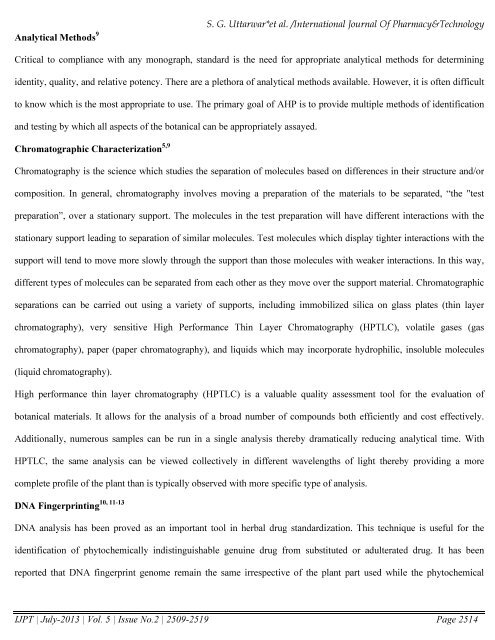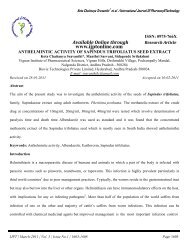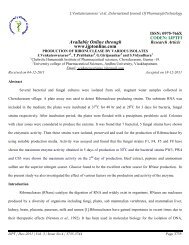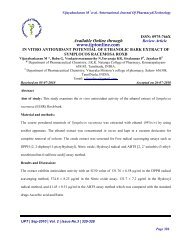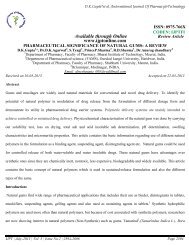Available through Online - International Journal of Pharmacy and ...
Available through Online - International Journal of Pharmacy and ...
Available through Online - International Journal of Pharmacy and ...
Create successful ePaper yourself
Turn your PDF publications into a flip-book with our unique Google optimized e-Paper software.
Analytical Methods 9S. G. Uttarwar*et al. /<strong>International</strong> <strong>Journal</strong> Of <strong>Pharmacy</strong>&TechnologyCritical to compliance with any monograph, st<strong>and</strong>ard is the need for appropriate analytical methods for determiningidentity, quality, <strong>and</strong> relative potency. There are a plethora <strong>of</strong> analytical methods available. However, it is <strong>of</strong>ten difficultto know which is the most appropriate to use. The primary goal <strong>of</strong> AHP is to provide multiple methods <strong>of</strong> identification<strong>and</strong> testing by which all aspects <strong>of</strong> the botanical can be appropriately assayed.Chromatographic Characterization 5,9Chromatography is the science which studies the separation <strong>of</strong> molecules based on differences in their structure <strong>and</strong>/orcomposition. In general, chromatography involves moving a preparation <strong>of</strong> the materials to be separated, “the "testpreparation”, over a stationary support. The molecules in the test preparation will have different interactions with thestationary support leading to separation <strong>of</strong> similar molecules. Test molecules which display tighter interactions with thesupport will tend to move more slowly <strong>through</strong> the support than those molecules with weaker interactions. In this way,different types <strong>of</strong> molecules can be separated from each other as they move over the support material. Chromatographicseparations can be carried out using a variety <strong>of</strong> supports, including immobilized silica on glass plates (thin layerchromatography), very sensitive High Performance Thin Layer Chromatography (HPTLC), volatile gases (gaschromatography), paper (paper chromatography), <strong>and</strong> liquids which may incorporate hydrophilic, insoluble molecules(liquid chromatography).High performance thin layer chromatography (HPTLC) is a valuable quality assessment tool for the evaluation <strong>of</strong>botanical materials. It allows for the analysis <strong>of</strong> a broad number <strong>of</strong> compounds both efficiently <strong>and</strong> cost effectively.Additionally, numerous samples can be run in a single analysis thereby dramatically reducing analytical time. WithHPTLC, the same analysis can be viewed collectively in different wavelengths <strong>of</strong> light thereby providing a morecomplete pr<strong>of</strong>ile <strong>of</strong> the plant than is typically observed with more specific type <strong>of</strong> analysis.10, 11-13DNA FingerprintingDNA analysis has been proved as an important tool in herbal drug st<strong>and</strong>ardization. This technique is useful for theidentification <strong>of</strong> phytochemically indistinguishable genuine drug from substituted or adulterated drug. It has beenreported that DNA fingerprint genome remain the same irrespective <strong>of</strong> the plant part used while the phytochemicalIJPT | July-2013 | Vol. 5 | Issue No.2 | 2509-2519 Page 2514


